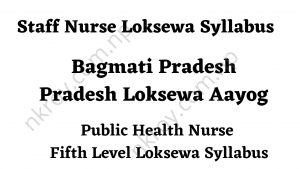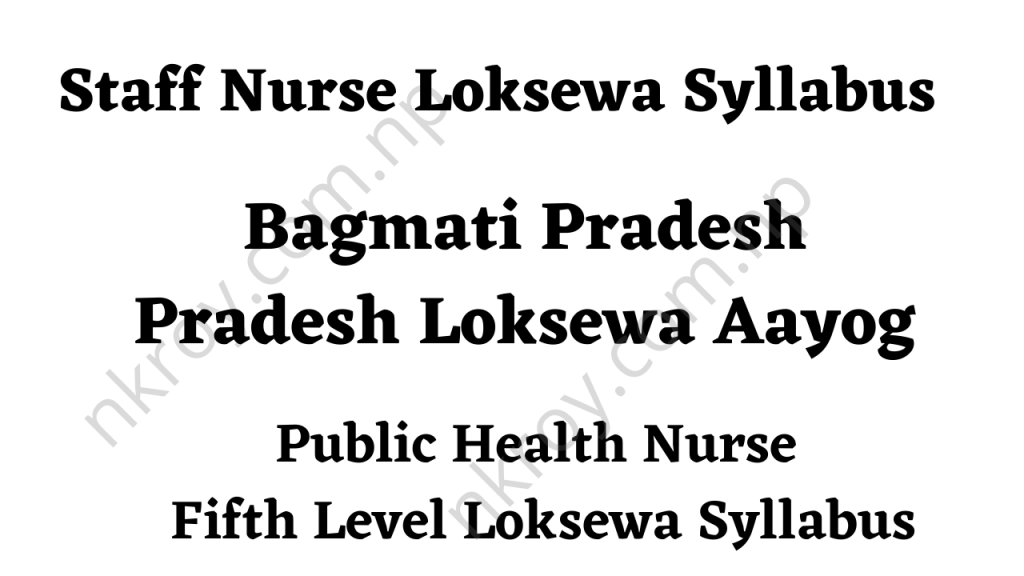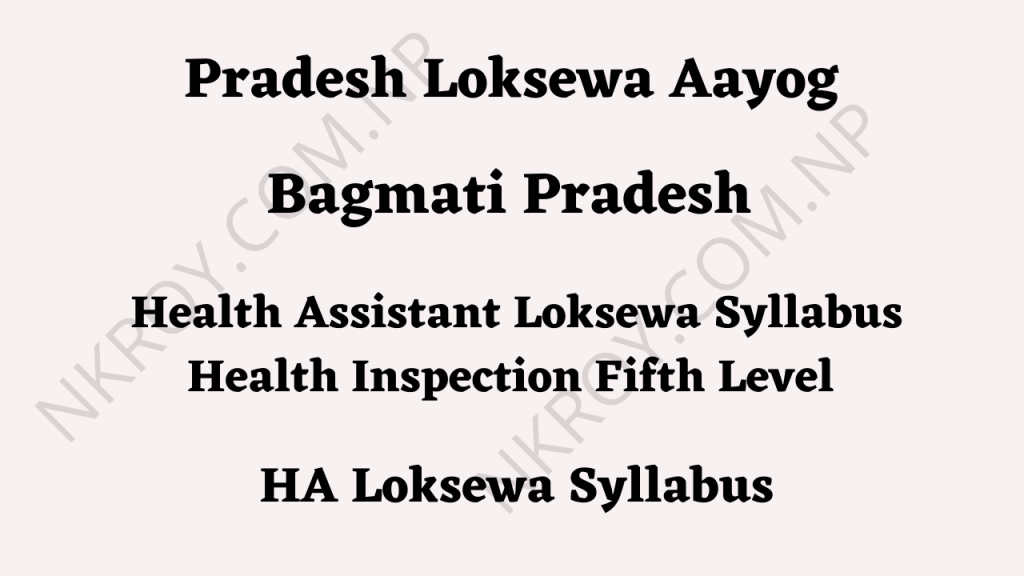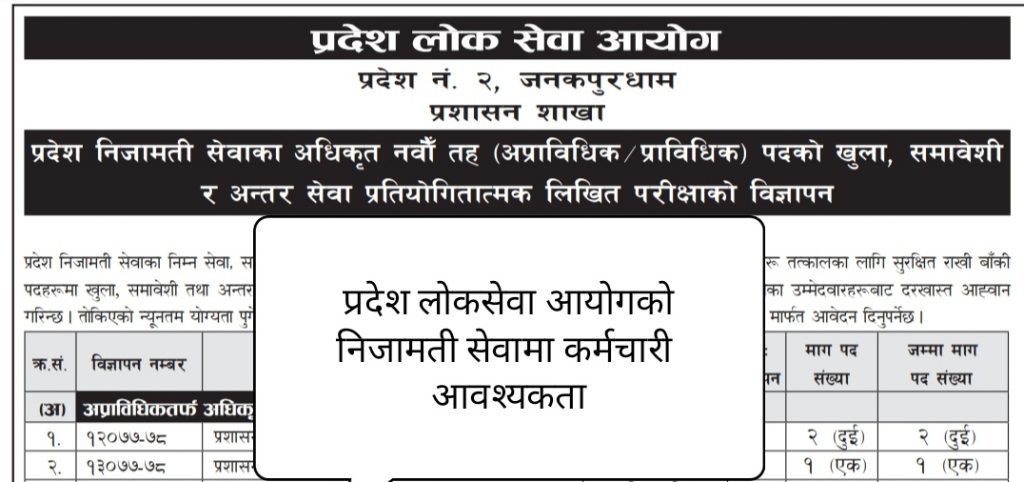Staff Nurse Loksewa Syllabus of Bagmati Pradesh Loksewa Aayog | Public Health Nurse Fifth Level Loksewa Syllabus
Are you searching for “Staff Nurse Loksewa Syllabus of Bagmati Province”?
If yes, then you are at right place. We are going to discuss the Staff Nurse Loksewa Syllabus of Bagmati Pradesh or, you can say Fifth Level Public Health Nurse as designed by the Public Service Commission of Bagmati Province.

This syllabus is designed for the competitive exam of fifth level public health nurse [Staff Nurse], Public Health Nursing group in the Health sector of Local-level and Provincial level.
Now, Let’s talk about the Fifth Level Staff Nurse Loksewa Syllabus of Bagmati Province.
As per the syllabus/curriculum, the competitive exam for the post of fifth level Public Health Nurse will be conducted in two phases.
- First Phase: Written Examination Full Marks: 100
- Second Phase: Interview Full Marks: 20
First Phase: Written Examination Scheme
- Subject: Service Related
- Full Marks: 100
- Pass Marks: 40
- Examination System: Objective Questions [Multiple Choice Questions (MCQs)]
- Number of Questions: 50; each Question consisting 2 Marks [50×2=100]
- Time: 45 minutes
Second Phase Examination: Interview
- Full marks: 20
- Examination System: Oral
NOTES: Some of the points to be noted and keep in mind while going through the curriculum/syllabus.
- The curriculum/syllabus is divided into two phases; Written exam and Interview.
- The question paper will be in the Nepali language.
- The exam will be conducted in English or Nepali or, both Nepali and English language.
- For each right answer, 2 marks will be provided and, 20% marks will be deducted in case of the wrong answer. No marks will be given or deducted if the question is unanswered.
- Use of calculator, mobile phones or any type of electronic devices is prohibited in the examination hall.
- As far as possible, the questions will be asked from each chapter as mentioned below.
| Units | A | B | C | D | E | F | G | H | I | J |
| No. of Questions | 4 | 4 | 6 | 10 | 6 | 6 | 4 | 6 | 2 | 2 |
7. Even, any of the Laws, Acts, Rules and Policies are written under this course plan. Laws, Acts, Rules and Policies in the syllabus which are Removed or Modified or, Added after Modification before three months of the conduction of the exam fall into this course.
8. Only the selected candidates from the first phase of examination will be called for interview in the second phase of the examination.
9. The curriculum is applicable from 2077/09/12 [12th Poush].
Staff Nurse Loksewa Syllabus of Bagmati Pradesh Loksewa Aayog | Public Health Nurse Fifth Level Loksewa Syllabus
Units included in the curriculum are mentioned as below:
A. Anatomy and Physiology
B. Fundamentals of Nursing
C. Nursing care of Adult
D. Community Health Nursing
E. Midwifery
F. Nursing Care of Children
G. Behavioural Science
H. Leadership and Management in Nursing
I. English
J. Nepali
These units have many sub-units mentioned as below:
A. Anatomy and Physiology
- Organs and functions of the different body system
1.1 General Concept (Cell, tissue embryology) Musculo-skeleton System
1.2 Respiratory system
1.3 Cardio-vascular System
1.4 Gastro-intestinal System
1.5 Urinary System
1.6 Reproductive System
1.7 Nervous System
1.8 Special Sensory and Integumentary System
1.9 Endocrine System
1.10 Blood, Lymphatic and Immune System
2. Body temperature regulation
2.1 Conduction
2.2 Convection
2.3 Radiation
2.4 Excretion (excretion)
3. Organisms and Parasites
3.1 Virus
3.2 Bacteria
3.3 Protozoa
3.4 Helminths
3.5 Fungi
4. Factors affecting microorganisms
4.1 Aerobic
4.2 Anaerobic
4.3 Temperature
4.4 Humidity
4.5 Nutrients
5. Mechanism of acid-base balance
5.1 Electrolyte
5.2 Relationship with respiration
5.3 Relation with excretion
6. Fluid and electrolyte replacement
6.1 Oral rehydration solution
6.2 Intravenous therapy
7. Pharmacokinetics
7.1 Absorption of drugs
7.2 Distribution of drugs
7.3 Metabolism of drugs
7.4 Excretion of drugs
8. Drugs acting on the endocrine system Why only endocrine ???
8.1 Insulin
8.2 Oral antidiabetic drugs
8.3 Thyroxine and antithyroid drugs
9. Uses of essential drugs in Nepal
B. Fundamentals of Nursing
1. Basic needs of clients: Maslow’s Hierarchy of need
2. Nursing process
3. Procedures used in physical assessment
3.1 Vital signs
3.2 Height and weight measurement
3.3 Others (lab. exam, x-ray, USG, MRI, CT, endoscopy)
4. Administration of drugs
4.1 Oral
4.2 Parental
4.3 Topical application
4.4 Instillation of drugs into eye, ear and nose
4.5 Oxygen administration
4.6 Blood transfusion
4.7 Steam inhalation and drug inhalation
5. First aid treatment
5.1 Drowning
5.2 Bites (Snake, insect and dog)
5.3 Choking
5.4 Hemorrhage and Shock
5.5 Poisoning
5.6 Burn
5.7 Wound and Fracture
5.8 Foreign body in ear, nose, eye and throat
6. Purposes, principles and methods of sterilization of different materials and equipment
7. Roles and responsibilities of nurses.
8. National and international professional organization related to nursing and its code of ethics
8.1 International Council of Nurses(ICN)
8.2 Nepal Nursing Council (NNC)
9. Stress and stress coping mechanism
10. Commonly used basic nursing procedures
10.1 Art and principles of bed making and pressure sore area care
10.2 Meeting personal hygiene needs (Oral, skin, hair, perineal care)
10.3 Fluid and Electrolyte balance
10.4 Elimination needs (catheterization, enema,sitz bath
10.5 Infection prevention (IP measures, hand washing, gloving and owning techniques, IP process and sterilization process)
10.6 Pre and post-operative care
10.7 Dressing and bandaging
C. Nursing care of Adult
1. Medical/surgical nursing management of the diseases/disorders condition in the different body system
1.1 Nervous System
1.1.1 Meningitis
1.1.2 Encephalitis
1.1.3 Tetanus
1.1.4 Poliomyelitis
1.1.5 Epilepsy
1.2 Respiratory System
1.2.1 Pleurisy
1.2.2 Pneumothorax
1.2.3 Influenza
1.2.4 Bronchitis
1.2.5 Pneumonia
1.2.6 Pulmonary TB
1.2.7 Bronchial asthma
1.2.8 Pulmonary embolism
1.2.9 COPD/ARDS
1.2.10 Asthma
1.3 Urinary system
1.3.1 Urinary Tract Infection(UTI)
1.3.2 Nephrotic syndrome
1.3.4 Renal and bladder calculi
1.3.5 Renal failure (acute and chronic)
1.3.6 Prostetic hyperplasia
1.3.7 Hydronephrosis
1.3.8 Glomerole nephritis (acute and chronic)
1.4 Gastro-intestinal System
1.4.1 Gastritis and Peptic ulcer
1.4.2 Oesophageal varices
1.4.3 Hernias
1.4.4 Appendicitis
1.4.5 Intestinal obstruction
1.4.6 Peritonitisand ascities
1.4.7 Tuberculosis ofabdomen
1.4.8 Ulcerative colitis
1.4.9 Hemorrhoids
1.4.10 Hepatitis
1.4.11 Cirrhosis of the liver
1.4.12 Cholecystitis and Cholelithiasis
1.4.13 Pancreatitis
1.5 Cardiovascular, Blood and Lymphatic System
1.5.1 Congestive cardiac failure
1.5.2 Angina pectoris
1.5.3 Cardiac arrest
1.5.4 Varicose vein, thrombophlebitis
1.5.5 Myocardial stenosis
1.5.6 Rheumatic heart disease
1.5.7 Cerebro-vascular accident
1.5.8 Blood diseases (anaemia, thalassemia, leukaemia)
1.5.9 Hodgkin’s disease and lymphoma
1.5.10 Hypertension
1.6 Endocrine System
1.6.1 Hyper and hypothyroidism
1.6.2 Diabetes insipidus
1.6.3 Diabetes mellitus
2. Reproductive System and Breast disorder
2.1 Disorder of uterine bleeding
2.2 Cystoceal and Rectoceal
2.3 Uterine prolapse
2.4 Vesico Vaginal Fistula(VVF) Infection of the genital tract
2.5 Sexually Transmitted Infection(STI)
2.6 Human Immune Deficiency Virus and Acquired Immune Deficiency Syndrome (HIV/AIDS)
2.7 Orchitis, prostate problems, hydrocele
2.8 Breast disorder
2.9 Infertility or Sub-fertility
3. Eye, Ear, Nose and Throat diseases and disorders
3.1 Eye
3.1.1 Conjunctivitisand sub-conjunctival haemorrhage
3.1.2 Blepharitis
3.1.3. Corneal ulcer, xeropthalmia, night blindness
3.1.4 Foreign body in the eye
3.1.5 Cataract
3.1.6 Glaucoma
3.2 Ear
3.2.1 Foreign body and impacted cerumen
3.2.2 Otitis media, Hearing impairment
3.2.3 Mastoiditis
3.2.4 Menier’s disease
3.3 Nose
3.3.1 Foreign body
3.3.2 Sinusitis
3.3.3 Epistaxis
3.3.4 Deviated nasal septum
3.3.5 nasal polyp
3.4 Throat
3.4.1 Foreign body
3.4.2 Laryngitis
3.4.3 Tonsillitis
3.4.4 Pharyngitis
4. Mental health problem in Nepal
5. Nurse’s – responsibilities in helping the individual and family in crisis
6. Service afford to the disabled individual during the rehabilitation.
7. Problem caused by immobility and their prevention
D. Community Health Nursing
1. Determinants of health
2. Primary health care (Definition, elements, principles)
3. Importance, advantages, principles and steps of home visit and Community bag technique
4. Nursing in the community setting
4.1 Maternal Child Health & Family Planning (MCH &FP)
4.2 School health nursing
4.3 Public health nursing
4.4 Industrial health nursing
4.5 Mental health nursing
4.6 Geriatric nursing
4.7 Rehabilitation nursing
5. Nutrition relation to health
5.1 Classification, functions and sources of nutrients
5.2 Nutritional assessment and deficiency disorders conditions
5.3 Current nutritional programs in Nepal
5.3.1 Vitamin A and K program
5.3.2 Iodized salt supplementation program
5.3.3 Distribution of iron folate tablet program
5.3.4 Promotion of exclusive breastfeeding
5.3.5 Deworming
5.4 Nutritional requirements in different stages of life
5.4.1 Pre-conception
5.4.2 Conception
5.4.3 Infant and childhood
5.4.4 Adolescent
5.4.5 Adult
5.4.6 Elderly
6. Communication (types, process/elements, barriers, principles of effective communication)
7. Epidemiology
7.1 Commonly used terms
7.2 Aims, uses and approaches
7.3 Epidemiological triad (agent, host and environment)
7.4 Modes of disease transmission
7.5 Level of disease prevention and modes of intervention
8. Immunization
8.1 Recommended immunization schedule for mothers and children by the National Immunization program (NIP)
8.2 Preparation, administration, storage and maintenance of Cold chain of vaccines
8.3 Normal phenomena and side effects of vaccines and health teaching
9. Commonly used vital and health indicators
9.1 Vital indicators (birth rate, death rate, population growth rate, life expectancy)
9.2 Health indicators (neonate mortality rate, infant mortality, under 5 mortality rate, maternal mortality rate, fertility rate, abortion rate)
9.3 Sources of statistical
10. Environmental sanitation
10.1 Refuses disposal
10.1.1 Sources and Methods of refuse disposal
10.1.2 Methods of sewage disposal
10.2 Water-sources, purification of water and water-related diseases
10.3 Human excreta disposal (methods of disposal and transmission of faecal borne diseases.
11. Health education
11.1 Purposes and principles of health education
11.2 Methods and media of health education including its advantages and disadvantages
12. Family health nursing
12.1 Functions and types of family
12.2 Freeman’s typology of family health problems (health threat, health deficit, foreseeable crisis)
12.3 Roles and functions of community health nurse in family health care
13. Home delivery:
13.1 Advantages, disadvantages and preparation for home delivery
13.2 Care of the mother
13.3 Care of the baby
14. Family planning
14.1 Methods of Family planning with counselling, preparation, doses, duration, mechanism of action, side effects, health teaching
15. Nutritional deficiencies diseases/disorders
15.1 Kwashiorkor, Marasmus, Night blindness, Goiter, Anemia
16. Housing
17. Occupational health and safety measures for the protection of the health of workers in different work settings
18. Community diagnosis and health action (purposes, process)
19. School health program
19.1 Objectives and activities/aspects
19.2 Common health problems of school children
19.3 School health nurse (criteria of SHN, function, roles)
E. Midwifery
1. Antenatal
1.2 Types of female pelvic and their effect on the birth of baby
1.3 Structure and function of female reproductive organs
1.4 Normal reproductive age and menopause
1.5 Development of fertilized ovum and foetus
1.6 Lie, presentation, attitude, denominator, position, presenting part, engagement, station.
1.7 Signs and symptoms of pregnancy.
1.8 Physical examination of an antenatal mother
1.9 Duration of pregnancy: Calculation of LMP (Last Menstrual Period) and EDD (Expected Date of Delivery) week of gestation
1.10 Growth of uterus and height in relation to gestation
1.11 Purpose of antenatal care and 4 focussed visits and also 8 visits
1.12 Need of pregnant mother.
1.13 Minor disorders of pregnancy
1.14 Bleeding in pregnancy
1.15 Major disorders of pregnancy
1.16 Disease associated with pregnancy
1.17 Anaemia, cardiac disease, diabetes, tuberculosis, sexually transmitted disease, urinary tract infection.
2. Labour
2.1 Labour and its stages
2.2 Signs and symptoms of the onset of true labour
2.3 Normal course of I, II, III,IVstages of labour
2.4 Mechanism of normal labour
2.5 Nursing care of the mother during each stage of labour
2.6 Signs and symptoms of the second stage, the third stage of labour and it’s management
2.7 Apgar score
2.8 Immediate care of the newborn baby
2.9 Signs & symptoms of separation of the placenta
2.10 Complications of 3rd and 4th stage of labour.
2.11 Needs and care of mother and newborn
2.12 Prolonged labour and its appropriate management
3. Postnatal
3.1 Definition and duration of puerperium
3.2 Principles of care in the puerperium
3.3 Need of postnatal mother
3.4 Minor disorders of puerperium.
3.5 Complications of puerperium
3.6 Breast feeding
3.7 Examination of a newborn baby
3.8 Congenital abnormalities
F. Nursing Care of Children
1. Definition of terms
1.2 Neonate
1.3 Infant
1.4 Toddler
1.5 Preschool
1.6 School-age
1.7 Adolescence
2. Developmental characteristic and milestones
3. Adolescent changes and problems
4. Six major killer disease????
4.1 Diarrhoea
4.2 Measles
4.3 Tetanus
4.4 Tuberculosis
4.5 Malnutrition
4.6 Acute Respiratory Infection(ARI)
5. Role of nurses in the reduction of mortality rate
6. Common health problems of children in Nepal and its nursing management and prevention
6.1 Dysentry
6.2 Worminfestation
6.3 Imperforatedanus
6.4 Undescended Testis
6.5 Phimosis
6.6 Hemophilia
6.7 Rheumatic fever
6.8 Rheumatic heart disease
6.9 Hair-lip
6.10 Cleft palate
7. Common health hazards of children in Nepal and its prevention
G. Behavioural Science
1. Factors and theories of effective learning
2. Characteristic of a mentally healthy person
3. Components of mental health assessment
4. Common mental health problem:
4.1 Psychosis
4.2 Neurosis
4.3 Personality disorder
4.4 Mental retardation
4.5 Substances and alcohol abuse
4.6 Suicide
H. Leadership and Management in Nursing
1. Leadership and Management
1.1 Principle of Management
1.2 Function of Management Process: Planning, Organizing, Staffing, Leading/Directing, Supervision, Controlling, Motivation, Implementation and Evaluation
1.3 Leadership Style; personal and professional development
1.4 Nursing process in relation to hospital unit management
1.5 Staff motivation in management to maintain the highest standard of care; delegation of responsibilities; Evaluation of staff performance and client satisfaction
1.6 Resources Management: Human, material, finance and time
1.7 Organizational Change
1.8 Conflict management
1.9 Stress management
1.10 Health-related fundamental rights and duties of the Constitution of Nepal
1.11 Health-related Directive Principles, Policies and Obligations of the State under Constitution of Nepal
1.12 Organizational structure of Government health services:
1.13 Ministry of Health and Population
1.14 Health-related activities of Ministry Social Development
1.15 Health-related aspects of Sustainable Development Goals
1.16 National health planning and concept of the national health system
1.17 Policies, rules and regulations in the management of the different level of hospitals and health centres
1.18 Communication Process.
1.19 Job description of various health personal working at a different level of institution
1.20 Disaster management
1.21 Cooperative and health
1.22 Health provisions in the current periodic plan of Bagamati Province
I. English:
Knowledge of writing correct English sentence, letter, and report according to English grammar based on the following syntactic functions:
a. Parts of Speech:
1. Noun
2. Pronoun
3. Adjective
4. Determiner
5. Verb
6. Adverb
7. Preposition
8. Conjunction and
9. Interjection
b. Infinitive and gerund, reported speech and tense
J. Nepali

“Staff Nurse Loksewa Syllabus of Bagmati Pradesh Loksewa Aayog | Public Health Nurse Fifth Level Loksewa Syllabus.”
Hope this Staff Nurse Loksewa syllabus will help you to prepare for your Loksewa exam of fifth level Public Health Nurse.
You can check Loksewa Syllabus of Other Health sectors from here: Health Loksewa Syllabus.
Follow our YouTube Channel “Health Sewa Tayari” for more study materials, model questions and much more stuff for Health sector Loksewa preparation in Nepal.


